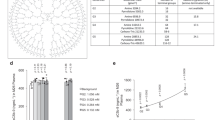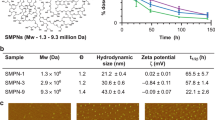Abstract
When nanoparticles are intravenously injected into the body, complement proteins deposit on the surface of nanoparticles in a process called opsonization. These proteins prime the particle for removal by immune cells and may contribute toward infusion-related adverse effects such as allergic responses. The ways complement proteins assemble on nanoparticles have remained unclear. Here, we show that dextran-coated superparamagnetic iron oxide core-shell nanoworms incubated in human serum and plasma are rapidly opsonized with the third complement component (C3) via the alternative pathway. Serum and plasma proteins bound to the nanoworms are mostly intercalated into the nanoworm shell. We show that C3 covalently binds to these absorbed proteins rather than the dextran shell and the protein-bound C3 undergoes dynamic exchange in vitro. Surface-bound proteins accelerate the assembly of the complement components of the alternative pathway on the nanoworm surface. When nanoworms pre-coated with human plasma were injected into mice, C3 and other adsorbed proteins undergo rapid loss. Our results provide important insight into dynamics of protein adsorption and complement opsonization of nanomedicines.
This is a preview of subscription content, access via your institution
Access options
Subscribe to this journal
Receive 12 print issues and online access
$259.00 per year
only $21.58 per issue
Buy this article
- Purchase on SpringerLink
- Instant access to full article PDF
Prices may be subject to local taxes which are calculated during checkout






Similar content being viewed by others
References
Moghimi, S. M., Hunter, A. C. & Andresen, T. L. Factors controlling nanoparticle pharmacokinetics: an integrated analysis and perspective. Annu. Rev. Pharmacol. Toxicol. 52, 481–503 (2012).
Blunk, T., Hochstrasser, D. F., Sanchez, J. C., Muller, B. W. & Muller, R. H. Colloidal carriers for intravenous drug targeting—plasma-protein adsorption patterns on surface-modified latex-particles evaluated by 2-dimensional polyacrylamide-gel electrophoresis. Electrophoresis 14, 1382–1387 (1993).
Lundqvist, M. et al. Nanoparticle size and surface properties determine the protein corona with possible implications for biological impacts. Proc. Natl Acad. Sci. USA 105, 14265–14270 (2008).
Chonn, A., Semple, S. C. & Cullis, P. R. Association of blood proteins with large unilamellar liposomes in vivo. Relation to circulation lifetimes. J. Biol. Chem. 267, 18759–18765 (1992).
Tenzer, S. et al. Rapid formation of plasma protein corona critically affects nanoparticle pathophysiology. Nat. Nanotech. 8, 772–781 (2013).
Salvati, A. et al. Transferrin-functionalized nanoparticles lose their targeting capabilities when a biomolecule corona adsorbs on the surface. Nat. Nanotech. 8, 137–143 (2013).
Mortimer, G. M. et al. Cryptic epitopes of albumin determine mononuclear phagocyte system clearance of nanomaterials. ACS Nano 8, 3357–3366 (2014).
Deng, Z. J., Liang, M., Monteiro, M., Toth, I. & Minchin, R. F. Nanoparticle-induced unfolding of fibrinogen promotes Mac-1 receptor activation and inflammation. Nat. Nanotech. 6, 39–44 (2011).
Walkey, C. D. et al. Protein corona fingerprinting predicts the cellular interaction of gold and silver nanoparticles. ACS Nano. 8, 2439–2455 (2014).
Karmali, P. P. & Simberg, D. Interactions of nanoparticles with plasma proteins: implication on clearance and toxicity of drug delivery systems. Exp. Opin. Drug Deliv. 8, 343–357 (2011).
Ricklin, D., Hajishengallis, G., Yang, K. & Lambris, J. D. Complement: a key system for immune surveillance and homeostasis. Nat. Immunol. 11, 785–797 (2010).
Moghimi, S. M. & Szebeni, J. Stealth liposomes and long circulating nanoparticles: critical issues in pharmacokinetics, opsonization and protein-binding properties. Prog. Lipid Res. 42, 463–478 (2003).
Moghimi, S. M. et al. Complement activation cascade triggered by PEG-PL engineered nanomedicines and carbon nanotubes: the challenges ahead. J. Control. Rel. 146, 175–181 (2010).
Salvador-Morales, C. et al. Complement activation and protein adsorption by carbon nanotubes. Mol. Immunol. 43, 193–201 (2006).
Andersen, A. J. et al. Single-walled carbon nanotube surface control of complement recognition and activation. ACS Nano 7, 1108–1119 (2013).
Hamad, I., Hunter, A. C. & Moghimi, S. M. Complement monitoring of Pluronic 127 gel and micelles: suppression of copolymer-mediated complement activation by elevated serum levels of HDL, LDL, and apolipoproteins AI and B-100. J. Control. Rel. 170, 167–174 (2013).
Devine, D. V., Wong, K., Serrano, K., Chonn, A. & Cullis, P. R. Liposome–complement interactions in rat serum: implications for liposome survival studies. Biochim. Biophys. Acta 1191, 43–51 (1994).
Borchard, G. & Kreuter, J. The role of serum complement on the organ distribution of intravenously administered poly(methyl methacrylate) nanoparticles: effects of pre-coating with plasma and with serum complement. Pharm. Res. 13, 1055–1058 (1996).
Hamad, I. et al. Distinct polymer architecture mediates switching of complement activation pathways at the nanosphere–serum interface: implications for stealth nanoparticle engineering. Acs Nano 4, 6629–6638 (2010).
Pedersen, M. B. et al. Curvature of synthetic and natural surfaces is an important target feature in classical pathway complement activation. J. Immunol. 184, 1931–1945 (2010).
Dobrovolskaia, M. A. et al. Interaction of colloidal gold nanoparticles with human blood: effects on particle size and analysis of plasma protein binding profiles. Nanomedicine 5, 106–117 (2009).
Andersson, J., Ekdahl, K. N., Lambris, J. D. & Nilsson, B. Binding of C3 fragments on top of adsorbed plasma proteins during complement activation on a model biomaterial surface. Biomaterials 26, 1477–1485 (2005).
Andersson, J., Ekdahl, K. N., Larsson, R., Nilsson, U. R. & Nilsson, B. C3 adsorbed to a polymer surface can form an initiating alternative pathway convertase. J. Immunol. 168, 5786–5791 (2002).
Hong, J., Azens, A., Ekdahl, K. N., Granqvist, C. G. & Nilsson, B. Material-specific thrombin generation following contact between metal surfaces and whole blood. Biomaterials 26, 1397–1403 (2005).
Gbadamosi, J. K., Hunter, A. C. & Moghimi, S. M. PEGylation of microspheres generates a heterogeneous population of particles with differential surface characteristics and biological performance. FEBS Lett. 532, 338–344 (2002).
Gupta, A. K. & Gupta, M. Synthesis and surface engineering of iron oxide nanoparticles for biomedical applications. Biomaterials 26, 3995–4021 (2005).
Park, J. H. et al. Systematic surface engineering of magnetic nanoworms for in vivo tumor targeting. Small 5, 694–700 (2009).
Park, J. H. et al. Magnetic iron oxide nanoworms for tumor targeting and imaging. Adv. Mater. 20, 1630–1635 (2008).
Kawaguchi, T. & Hasegawa, M. Structure of dextran–magnetite complex: relation between conformation of dextran chains covering core and its molecular weight. J. Mater. Sci. Mater. Med. 11, 31–35 (2000).
Jung, C. W. Surface properties of superparamagnetic iron oxide MR contrast agents: ferumoxides, ferumoxtran, ferumoxsil. Magn. Reson. Imaging 13, 675–691 (1995).
Alcorlo, M., Tortajada, A., Rodriguez de Cordoba, S. & Llorca, O. Structural basis for the stabilization of the complement alternative pathway C3 convertase by properdin. Proc. Natl Acad. Sci. USA 110, 13504–13509 (2013).
Gupta-Bansal, R., Parent, J. B. & Brunden, K. R. Inhibition of complement alternative pathway function with anti-properdin monoclonal antibodies. Mol. Immunol. 37, 191–201 (2000).
Carlsson, F., Sandin, C. & Lindahl, G. Human fibrinogen bound to Streptococcus pyogenes M protein inhibits complement deposition via the classical pathway. Mol. Microbiol. 56, 28–39 (2005).
Pelaz, B. et al. Surface functionalization of nanoparticles with polyethylene glycol: effects on protein adsorption and cellular uptake. ACS Nano 9, 6996–7008 (2015).
Simberg, D. et al. Differential proteomics analysis of the surface heterogeneity of dextran iron oxide nanoparticles and the implications for their in vivo clearance. Biomaterials 30, 3926–3933 (2009).
Arima, Y., Kawagoe, M., Toda, M. & Iwata, H. Complement activation by polymers carrying hydroxyl groups. ACS Appl. Mater. Interfaces 1, 2400–2407 (2009).
Lemarchand, C. et al. Influence of polysaccharide coating on the interactions of nanoparticles with biological systems. Biomaterials 27, 108–118 (2006).
Venkatesh, Y. P., Minich, T. M., Law, S. K. & Levine, R. P. Natural release of covalently bound C3b from cell surfaces and the study of this phenomenon in the fluid-phase system. J. Immunol. 132, 1435–1439 (1984).
Cedervall, T. et al. Understanding the nanoparticle–protein corona using methods to quantify exchange rates and affinities of proteins for nanoparticles. Proc. Natl Acad. Sci. USA 104, 2050–2055 (2007).
Gadd, K. J. & Reid, K. B. The binding of complement component C3 to antibody–antigen aggregates after activation of the alternative pathway in human serum. Biochem. J. 195, 471–480 (1981).
Zhou, H. F. et al. Antibody directs properdin-dependent activation of the complement alternative pathway in a mouse model of abdominal aortic aneurysm. Proc. Natl Acad. Sci. USA 109, E415–E422 (2012).
Zipfel, P. F. & Skerka, C. Complement regulators and inhibitory proteins. Nat. Rev. Immunol. 9, 729–740 (2009).
Moghimi, S. M. Cancer nanomedicine and the complement system activation paradigm: anaphylaxis and tumour growth. J. Control. Rel. 190, 556–562 (2014).
Zamboni, W. C. et al. Bidirectional pharmacodynamic interaction between pegylated liposomal CKD-602 (S-CKD602) and monocytes in patients with refractory solid tumors. J. Liposome Res. 21, 158–165 (2011).
Moghimi, S. M., Hunter, A. C. & Murray, J. C. Long-circulating and target-specific nanoparticles: theory to practice. Pharmacol. Rev. 53, 283–318 (2001).
Hamada, I., Hunter, A. C., Szebeni, J. & Moghimi, S. M. Poly(ethylene glycol)s generate complement activation products in human serum through increased alternative pathway turnover and a MASP-2-dependent process. Mol. Immunol. 46, 225–232 (2008).
Dai, Q., Walkey, C. & Chan, W. C. Polyethylene glycol backfilling mitigates the negative impact of the protein corona on nanoparticle cell targeting. Angew. Chem. Int. Ed. 53, 5093–5096 (2014).
Wu, Y. Q. et al. Protection of nonself surfaces from complement attack by factor H-binding peptides: implications for therapeutic medicine. J. Immunol. 186, 4269–4277 (2011).
Thomas, S. N. et al. Engineering complement activation on polypropylene sulfide vaccine nanoparticles. Biomaterials 32, 2194–2203 (2011).
Pauly, D. et al. A novel antibody against human properdin inhibits the alternative complement system and specifically detects properdin from blood samples. PLoS ONE 9, e96371 (2014).
Kozel, T. R., Wilson, M. A., Pfrommer, G. S. & Schlageter, A. M. Activation and binding of opsonic fragments of C3 on encapsulated Cryptococcus neoformans by using an alternative complement pathway reconstituted from six isolated proteins. Infect. Immun. 57, 1922–1927 (1989).
Molday, R. S. & MacKenzie, D. Immunospecific ferromagnetic iron–dextran reagents for the labeling and magnetic separation of cells. J. Immunol. Methods 52, 353–367 (1982).
Wang, G. et al. High-relaxivity superparamagnetic iron oxide nanoworms with decreased immune recognition and long-circulating properties. ACS Nano 8, 12437–12449 (2014).
Reynolds, F., O'Loughlin, T., Weissleder, R. & Josephson, L. Method of determining nanoparticle core weight. Anal. Chem. 77, 814–817 (2005).
Bautista, M. C., Bomati-Miguel, O., Morales, M. D., Serna, C. J. & Veintemillas-Verdaguer, S. Surface characterisation of dextran-coated iron oxide nanoparticles prepared by laser pyrolysis and coprecipitation. J. Magn. Magn. Mater. 293, 20–27 (2005).
Harpaz, Y., Gerstein, M. & Chothia, C. Volume changes on protein folding. Structure 2, 641–649 (1994).
Quillin, M. L. & Matthews, B. W. Accurate calculation of the density of proteins. Acta Crystallogr. D 56, 791–794 (2000).
Wisniewski, J. R., Zougman, A., Nagaraj, N. & Mann, M. Universal sample preparation method for proteome analysis. Nat. Methods 6, 359–362 (2009).
Inturi, S. et al. Modulatory role of surface coating of superparamagnetic iron oxide nanoworms in complement opsonization and leukocyte uptake. ACS Nano 9, 10758–10768 (2015).
Forneris, F. et al. Structures of C3b in complex with factors B and D give insight into complement convertase formation. Science 330, 1816–1820 (2010).
Acknowledgements
The study was funded by the University of Colorado Denver start-up funding and NIH 1R01EB022040 to D.S. F.C. was supported by the International Postdoctoral Exchange Fellowship Program (2013) from China Postdoctoral Council. Molecular modelling studies were conducted at the University of Colorado Computational Chemistry and Biology Core Facility, which is supported in part by NIH/NCATS Colorado CTSA grant no. UL1 TR001082. S.M.M. acknowledges financial support by the Danish Agency for Science, Technology and Innovation (Det Strategiske Forskningsråd), reference 09-065746, and Technology and Production, reference 12-126894.
Author information
Authors and Affiliations
Contributions
F.C., G.W., J.I.G., B.B. and L.W. performed the experiments. D.S.B. performed complement modelling. S.M.M., N.K.B., V.M.H. and D.S. analysed the data and edited the manuscript. N.K.B. and V.M.H. provided critical reagents. S.M.M. and D.S. wrote the manuscript.
Corresponding author
Ethics declarations
Competing interests
The authors declare no competing financial interests.
Supplementary information
Supplementary information
Supplementary information (PDF 2609 kb)
Supplementary information
Supplementary information (XLSX 90 kb)
Rights and permissions
About this article
Cite this article
Chen, F., Wang, G., Griffin, J. et al. Complement proteins bind to nanoparticle protein corona and undergo dynamic exchange in vivo. Nature Nanotech 12, 387–393 (2017). https://doi.org/10.1038/nnano.2016.269
Received:
Accepted:
Published:
Issue Date:
DOI: https://doi.org/10.1038/nnano.2016.269



